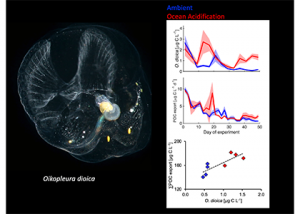If you would like to have your recent publications featured on the OCB website please contact ocb_news@whoi.edu. View our guidelines for writing a New OCB Research post.
The ocean’s biological carbon pump (BCP) plays a crucial role in regulating Earth’s climate. But how efficiently does it transport carbon to the deep? It has been difficult to answer this question because observations are sparse, labor-intensive, and the uncertainties of the BCP’s magnitude, which are nearly equivalent to human emissions. Fortunately, autonomous vehicles unlock […]
Read MoreNew over-determined CO2 system solver QUODcarb
Do you work with over-determined datasets of seawater carbon dioxide system chemistry? QUODcarb (Quantifying Uncertainty in an Over-Determined marine carbonate system), a new over-determined CO2-system solver is described in the recently published “QUODcarb: A Bayesian solver for over-determined datasets of seawater carbon dioxide system chemistry.” The Bayesian formulation of the novel solver and demonstrates its […]
Read MorePhotoacclimation by phytoplankton under clouds
Unlike most remote sensing products, Net Primary Production (NPP) is computed under clouds. Since satellites can’t see through clouds, NPP models rely on clear-sky observations, interpolate model inputs, and assume that phytoplankton behavior stays the same, regardless of light conditions. But phytoplankton are known to photoacclimate, adjusting their internal chlorophyll to carbon ratio in response […]
Read MoreMicrobial Iron limitation in the ocean’s twilight zone
How deep in the ocean do microbes feel the effects of nutrient limitation? Microbial production in one third of the surface ocean is limited by the essential micronutrient iron (Fe). This limitation extends to at least the bottom of the euphotic zone, but what happens below that? In a study that recently published in Nature […]
Read MoreHow do ocean microbes share the job of denitrification?
Denitrification is a crucial multi-step process for ecosystem productivity and sustainability because some of its steps can result in the loss of the essential nutrient nitrogen or the production of greenhouse gas nitrous oxide. We do not understand why microbial functional groups conducting different steps of denitrification can coexist in the ocean and why certain […]
Read MoreThe ocean is shifting toward phosphorus limitation
Biogeochemical models predict that ocean warming is weakening the vertical transport of nutrients to the upper ocean, with severe implications for marine productivity. However, nutrient concentrations across the ocean surface often fall below detection limits, making it difficult to observe long-term changes. In a recent study in PNAS, we analyzed over 30,000 nitrate and phosphate […]
Read MorePersistent bottom trawling impairs seafloor carbon sequestration
Bottom trawling, a fishing method that uses heavy nets to catch animals that live on and in the seafloor, could release a large amount of organic carbon from seafloor into the water, that metabolizes to CO2 then outgasses to the atmosphere. The magnitude of this indirect emission has been heavily debated, with estimates spanning from […]
Read MoreRain increases the global carbon sink
The global ocean dampens the anthropic CO2 increase in the atmosphere by absorbing around 25% of the carbon emitted each year. Of the processes involved in exchanges of energy and mass between ocean and atmosphere that may impact this carbon sink, rainfall has never been systematically and comprehensively quantified. A study recently published in Nature […]
Read MoreDeep dive into carbon transport: How bacteria feast and compete on lipids in sinking particles
What drives carbon from the atmosphere to the deep ocean? The journey of phytoplankton-derived carbon is critical in the global carbon cycle, yet the influence of interacting bacteria in degrading lipid-rich particles during their descent has remained a mystery—until now. Using an innovative combination of nano-scale lipidomics and microscopy, researchers investigated how bacteria target and […]
Read MoreOA could boost carbon export by appendicularia
Gelatinous zooplankton comprise a widespread group of animals that are increasingly recognized as important components of pelagic ecosystems. Historically understudied, we have little knowledge of how much key taxa contribute to carbon fluxes. Likewise, there’s a critical knowledge gap of the impact of ocean change on these taxa. Appendicularia are the most abundant gelatinous zooplankton […]
Read More












